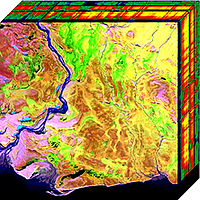
Photo from wikipedia
In recent years, more concerns are shed on the lightweight detection model in remote sensing (RS), but it is difficult to reach a competitive performance relative to the deep model.… Click to show full abstract
In recent years, more concerns are shed on the lightweight detection model in remote sensing (RS), but it is difficult to reach a competitive performance relative to the deep model. Knowledge distillation has been verified as a promising method, which can promote the performance of the lightweight model without extra parameters. While there are two key issues of detection distillation, one is the sample selection and the other is the knowledge selection. Since the varying object size and complex features in RS, the existing methods based on the fixed threshold are incapable of selecting the optimal distillation samples and they also ignore the potential multivariate knowledge among RS samples simultaneously. In this article, we propose a statistical sample selection and multivariate knowledge mining framework. The statistical sample selection module formulates the task as the modeling and splitting of the probability distribution of sample selection cost, which is more suitable for dynamically choosing multiscale samples in RS and eliminates the distortion of previous static distillation selection. Furthermore, to mine the complex feature knowledge of samples in RS, we design a multivariate knowledge mining module, in which knowledge includes explicit and implicit knowledge. The proposed module validly delivers the core knowledge from the teacher model to the lightweight model. Massive experiments on three challenging RS datasets [a large-scale Dataset for Object deTection in Aerial images (DOTA), Northwestern Polytechnical University very-high-resolution 10-class (NWPU VHR-10), and object DetectIon in Optical Remote sensing images (DIOR)] prove that our method achieves state-of-the-art performance.
Journal Title: IEEE Transactions on Geoscience and Remote Sensing
Year Published: 2022
Link to full text (if available)
Share on Social Media: Sign Up to like & get
recommendations!